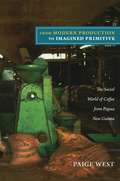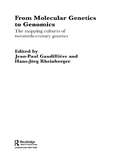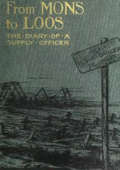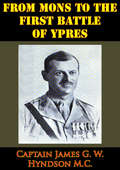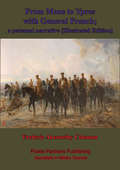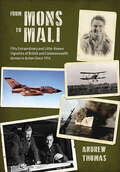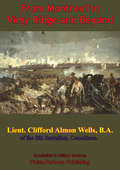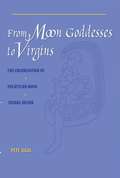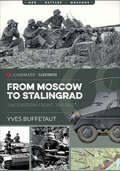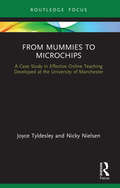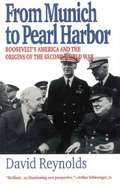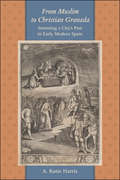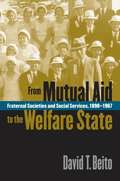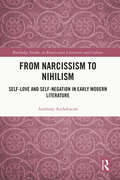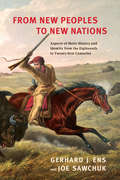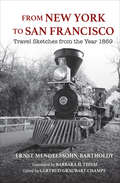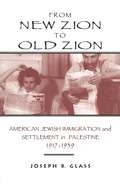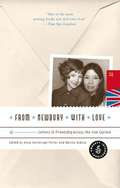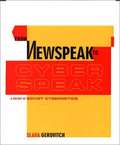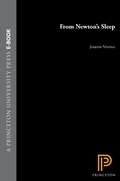- Table View
- List View
From Modern Production to Imagined Primitive: The Social World of Coffee from Papua New Guinea
by Paige WestIn this vivid ethnography, Paige West tracks coffee as it moves from producers in Papua New Guinea to consumers around the world. She illuminates the social lives of the people who produce coffee, and those who process, distribute, market, and consume it. The Gimi peoples, who grow coffee in Papua New Guinea's highlands, are eager to expand their business and social relationships with the buyers who come to their highland villages, as well as with the people working in Goroka, where much of Papua New Guinea's coffee is processed; at the port of Lae, where it is exported; and in Hamburg, Sydney, and London, where it is distributed and consumed. This rich social world is disrupted by neoliberal development strategies, which impose prescriptive regimes of governmentality that are often at odds with Melanesian ways of being in, and relating to, the world. The Gimi are misrepresented in the specialty coffee market, which relies on images of primitivity and poverty to sell coffee. By implying that the "backwardness" of Papua New Guineans impedes economic development, these images obscure the structural relations and global political economy that actually cause poverty in Papua New Guinea.
From Molecular Genetics to Genomics: The Mapping Cultures of Twentieth-Century Genetics (Routledge Studies in the History of Science, Technology and Medicine)
by Hans-Jörg Rheinberger Jean-Paul GaudillièreWith the rise of genomics, the life sciences have entered a new era. Maps of genomes have become the icons for a comprehensive knowledge of the organism on a previously unattained level of complexity, and the organisation of genetic knowledge in maps has been a major driving force in the establishment of the discipline. This book provides a comprehensive history of molecular genetics and genomics.The first section of the book shows how the genetic cartography of classical genetics was linked to the molecular analysis of gene structure through the introduction of new model organisms such as bacteria and through the invention of new experimental tools such as gene transfer. The second section addresses the moral and political economy of human genome sequencing in all its technical, epistemic, social and economic complexity.With detailed analyses of the scientific practices of mapping and its illustration of the diversity of mapping practices this book is a significant contribution to the history of genetics. A companion volume from the same editors - Classical Genetic Research and Its Legacy: The Mapping Cultures of Twentieth Century Genetics - covers the history of mapping procedures as they were developed in classical genetics.
From Mons To Loos - The Diary Of A Supply Officer [Illustrated Edition]
by Major Herbert A. StewartIncludes with 21 illustrations and photos.A member of General French's "Contemptible" little army recounts his tales of the opening two years of the First World War. Under shot and shell in the front lines with the gallant Tommies of the BEF from the first engagements until the bloody battle of Loos."THIS little work does not profess to be a record of historical facts, but merely a series of impressions snap-shotted upon my mind as they occurred, and set down here in simple language; and if these snapshots can bring home to my readers some idea, however faint, of what war and its attendant miseries mean, then my labour will not have been in vain."To those who may imagine that the British fighting man of to-day is not the equal of his forebears, who fought from Crécy and Agincourt to Albuera and Waterloo, I trust the story of Mons, the Aisne, Neuve Chapelle, and Ypres will set all doubts at rest."STEWART, HERBERT ARTHUR, Major, was born 18 May, 1878, and was commissioned from the Militia 4 Jan. 1899, in the Suffolk Regt., from which he was transferred to the Army Service Corps 12 Feb. 1900. Capt. Stewart served in the South African War, 1899-1902, he received the Queen's Medal with three clasps, and the King's Medal with two clasps. He was Adjutant, Territorial Force, 1 Aug. 1911, to 31 July, 1914. He again saw active service in the European War from Aug. 1914, to the conclusion of hostilities, becoming Major the day war broke out. He was one of the very few British officers who entered Mons on Sunday, 23 Aug. 1914. For his services with the 3rd Division during the First Battles of Neuve Chapelle and Ypres in Oct. and Nov. 1914, he received a D.S.O. awarded "for services in connection with operations in the field."
From Mons To The First Battle Of Ypres [Illustrated Edition]
by Captain James G. W. Hyndson M.C.Includes The First World War On The Western Front 1914-1915 Illustrations Pack with 101 maps, plans, and photos.An exceptional and vivid account of the opening battles of the First World War with the B.E.F.. Captain Hyndson was with the Loyal North Lancashire Regiment during the retreat from Mons until the First Battle of Ypres during which he was wounded and invalided back to Blighty. In recognition of his bravery he was awarded the Military Medal in 1915."As there has as yet been published no connected account of the first phase of the Great War from a Regimental Officer's point of view, I have been persuaded to put into book form the diary which I began on the first day of mobilization and kept up until I was invalided home from the French Front in 1915. As far as I am aware, there are only three or four platoon and company commanders still living who went through the Battle of, and Retreat from, Mons, as well as the Battles of the Marne, the Aisne and Ypres. This fact has emboldened me to add one more book to the already enormous bulk of war literature.It is also my desire to place on record the wonderful devotion to duty and the sterling fighting qualities of the men of Lancashire Nulli Secundus."- The Author.
From Mons To Ypres With General French; A Personal Narrative [Illustrated Edition]
by Frederic Abernethy ColemanWhen the British troops advanced into Belgium in 1914 to face the German foe, it was with a sure and steady confidence in the outcome. These same men trudged back, grumbling, along the same path toward France as the full weight of the German steamroller advanced toward the numerically small British Expeditionary Force. At Mons they turned at bay and gave the Germans a tough time, but little more than a check as two corps could not hold up two huge armies. As the static battlelines began to coalesce, from Switzerland to the English channel, the fierce fighting flared up for any advantageous town, and none more so than Ypres. The first battle of Ypres was a bitter, bloody affair which ended the German advance but at terrible cost to the last of the regular soldiers of the B.E.F.Along with these hardened professional soldiers went a handful of amateurs determined to help; these members of the Royal Automobile Club with their motor cars were attached to various headquarters to aid in transmission of orders. As the eyes and ears of the army, the two cavalry brigade were in need of the most help from the R.A.C. volunteers as they ranged far and wide. The author was attached to the cavalry during retreat from Mons to the first battle of Ypres; he admired and had grown fond of the men with whom he had shared much danger. His post enabled him to meet a great number of the high-ranking officers, and in his capacity as messenger would have been better informed than most. His book is excellently written and deserves reading and re-reading.Author -- Frederic Abernethy Coleman 1876-1931Text taken, whole and complete, from the edition published in New York, Dodd, Mead and company, 1916.Original Page Count - xvii and 381 pages.Illustrations - 50 illustrations.
From Mons to Mali: Fifty Extraordinary and Little-Known Vignettes of British and Commonwealth Airmen in Action since 1914
by Andrew ThomasAcclaimed author Andrew Thomas has chosen fifty fascinating cameos of individual actions or incidents across a wide variety of major and minor campaigns and scenarios ranging from the First World War to the present day. Each selection is accompanied by relevant, often rare, photographs. So, from the Battle of Mons in 1914 through shooting down a Zeppelin over Teeside, to WW2 Timor Ace ‘Butch’ Gordon in his Beaufighter in 1943 and a nightmare for Halifaxes over Nuremburg in 1944, to SAAF fighters over Angola in September 1985 and army support tasks in Mali in 2021, with many more in between, the author’s hand-picked personal choices make for gripping reading. A must for all those interested in the war in the air throughout history.
From Montaigne to Montaigne
by Claude Lévi-StraussTwo previously unpublished lectures charting the renowned anthropologist&’s intellectual engagement with the sixteenth-century French essayist Michel de Montaigne In January 1937, between the two ethnographic trips he would describe in Tristes Tropiques, Claude Lévi-Strauss gave a talk to the Confédération générale du travail in Paris. Only recently discovered in the archives of the Bibliothèque national de France, this lecture, &“Ethnography: The Revolutionary Science,&” discussed the French essayist Michel de Montaigne, to whom Lévi-Strauss would return in remarks delivered more than a half-century later, in the spring of 1992. Bracketing the career of one of the most celebrated anthropologists of the twentieth century, these two talks reveal how Lévi-Strauss&’s ethnography begins and ends with Montaigne—and how his reading of his intellectual forebear and his understanding of anthropology evolve along the way.Published here for the first time, these lectures offer new insight into the development of ethnography and the thinking of one of its most important practitioners. Essays by Emmanuel Désveaux, who edited the original French volume De Montaigne à Montaigne, and Peter Skafish expand the context of Lévi-Strauss&’s talks with contemporary perspectives and commentary.
From Montreal To Vimy Ridge And Beyond; The Correspondence Of Lieut. Clifford Almon Wells, B.A.,: Of The 8th Battalion, Canadians, B.E.F., November, 1915-April, 1917
by Lieutenant Clifford Almon WellsClifford Almon Wells was born in Toronto, Canada, March 12th, 1892. His teaching career at Johns Hopkins University was bought to a end when he decided in the summer of 1915 that it was his duty to relinquish his position and take his part as a Canadian in the European war. In Sep. he enlisted as a Private in the 4th University Company, one of the reinforcing companies of the famous Princess Patricia's Canadian Light Infantry. Although without previous military training his advancement was rapid, later he was transferred to the 8th Battalion as 2nd Lieutenant.His letters cover a period of eighteen months. They were written in railway cars and on board ship; in tents in England, Belgium and France; in huts, shacks, furnace rooms and ruined houses; in London boarding houses and hotels; in French farm-houses, and German dugouts; in the midst of the awful clamors and crashings and thunders of artillery, and within sound of the coughing of a sick German in the front line of enemy trenches.He wrote of things which others have written about; of things which pleased him, and of other things which displeased him, most of these relating to the commonplace of life. But in addition to the commonplace there will be found in these letters a surprising variety of topics, and withal such graphic descriptions, thrilling or amusing stories, and information on many matters of interest to all who have friends overseas that the letters will both entertain and enlighten.His last dated letter was written the 20th day of April, 1917, eleven days after the battle of Vimy Ridge. Thankful because he had had a part in that battle, exultant and confident in view of the great victory, but before this letter reached her she had received official notice that he had been killed in action the 28th day of April.
From Moon Goddesses to Virgins: The Colonization of Yucatecan Maya Sexual Desire
by Pete SigalFor the preconquest Maya, sexuality was a part of ritual discourse and performance, and all sex acts were understood in terms of their power to create, maintain, and destroy society. As postconquest Maya adapted to life under colonial rule, they neither fully abandoned these views nor completely adopted the formulation of sexuality prescribed by Spanish Catholicism. Instead, they evolved hybridized notions of sexual desire, represented in the figure of the Virgin Mary as a sexual goddess, whose sex acts embodied both creative and destructive components.<P><P>This highly innovative book decodes the process through which this colonization of Yucatan Maya sexual desire occurred. Pete Sigal frames the discussion around a series of texts, including the Books of Chilam Balam and the Ritual of the Bacabs, that were written by seventeenth and eighteenth century Maya nobles to elucidate the history, religion, and philosophy of the Yucatecan Maya communities. Drawing on the insights of philology, discourse analysis, and deconstruction, he analyzes the sexual fantasies, fears, and desires that are presented, often unintentionally, in the "margins" of these texts and shows how they illuminate issues of colonialism, power, ritual, and gender.
From Moscow to Stalingrad: The Eastern Front, 1941-1942 (Casemate Illustrated #Cis0005)
by Yves BuffetautA concise and entertaining history of the Roman legionary—from the age of Augustus through the heyday of the Roman Empire.The might of Rome rested on the back of its legions; the superbly trained and equipped fighting force with which the imperial Roman army conquered, subdued and ruled an empire for centuries. The legionary soldier served for 20 years, was rigorously trained, highly equipped, and motivated by pay, bonuses and a strong sense of identity and camaraderie. Legionaries wore full body-armor and carried a shield, as well as two javelins, a sword, and a dagger. In battle they hurled their javelins and then immediately drew their swords and charged to close combat with the enemy. They were the finest heavy infantrymen of antiquity, and a massed legionary charge was a fearsome sight.In The Roman Legionaries, Simon Elliott, author of Julius Caesar: Rome’s Greatest Warlord, provides an introduction to these elite soldiers, including their training, tactics, weapons, the men themselves, life on and off the battlefield, as well as significant triumphs and disasters in the great battles of the era.
From Mouse to Mermaid: The Politics of Film, Gender, and Culture
by Elizabeth Bell, Lynda Haas, Laura SellsA collection of essays that explicate Disney ideology through fifty-five years of feature films, including Bambi, Beauty and the Beast, Pinocchio, and more.From Mouse to Mermaid, an interdisciplinary collection of original essays, is the first comprehensive, critical treatment of Disney cinema. Addressing children’s classics as well as the Disney affiliates’ more recent attempts to capture adult audiences, the contributors respond to the Disney film legacy from feminist, marxist, poststructuralist, and cultural studies perspectives. The volume contemplates Disney’s duality as an American icon and as an industry of cultural production, created in and through fifty years of filmmaking. The contributors treat a range of topics at issue in contemporary cultural studies: the performance of gender, race, and class; the engendered images of science, nature, technology, family, and business. The compilation of voices in From Mouse to Mermaid creates a persuasive cultural critique of Disney’s ideology.The contributors are Bryan Attebery, Elizabeth Bell, Claudia Card, Chris Cuomo, Ramona Fernandez, Henry A. Giroux, Robert Haas, Lynda Haas, Susan Jeffords, N. Soyini Madison, Susan Miller, Patrick Murphy, David Payne, Greg Rode, Laura Sells, and Jack Zipes.“In this volume of 16 essays about Disney films, several pieces . . . begin the work of filling in a major gap in our understanding of animation.” —Film Quarterly
From Mummies to Microchips: A Case-Study in Effective Online Teaching Developed at the University of Manchester
by Joyce Tyldesley Nicky NielsenThis volume offers a detailed case study of the internationally acclaimed online programmes in Egyptology at the University of Manchester, UK. It distils over a decade of online teaching experience and student feedback, providing guidance for instructors developing their own online offerings. Today, many universities are actively encouraging their teaching staff towards the development of: • online programmes (programmes to be taught entirely online) and/or • online units (units to be incorporated into “blended” programmes taught partially online and partially face-to-face). Unfortunately, the staff tasked with the development of online learning rarely have access to the expertise that they need to help them utilise their teaching skills to their full potential. Technical assistance may be provided by the university e-learning department, but pedagogical and practical help – the support of colleagues with many years’ experience teaching online – is lacking. Written by experts, the book provides an invaluable guide for those wishing – or being compelled – to establish their own online courses within the humanities.
From Munich To Pearl Harbor: Roosevelt's America And The Origins Of The Second World War (American Ways Series)
by David ReynoldsFour years before Pearl Harbor, the United States had turned in on itself, mired in the Great Depression and fearing entanglement in another European war. Four years after Pearl Harbor, it accounted for half the world's economic output and boasted a navy and air force second to none. The period from 1938 to 1941, David Reynolds argues in his brilliant new book, was a turning point in modern American history. Drawing upon his own research and the latest scholarship, Mr. Reynolds shows how Franklin Roosevelt led Americans into a new global perspective on foreign policy, one based on geopolitics and ideology. FDR insisted that in an age of airpower, U.S. security required allies far beyond the Western Hemisphere, and that in an era of dictatorships, American values could and should transform the world. Months before Pearl Harbor, he had popularized the term "second world war." Mr. Reynolds, in his succinct overview of American foreign policy from Munich to Pearl Harbor, shows how the president used his new perspective in responding to international shocks—the fall of France, Hitler's invasion of Russia, Japan's drive into Southeast Asia. But one of the signal accomplishments of From Munich to Pearl Harbor is also to explain how the main features of America's cold war posture (following World War II) were established in the years before the war—a new globalism, a bipolar worldview, the foundations of the military-industrial complex, and the origins of the "imperial presidency."
From Muslim to Christian Granada: Inventing a City's Past in Early Modern Spain (The Johns Hopkins University Studies in Historical and Political Science #125)
by A. Katie HarrisHonorable Mention, 2010 Best First Book, Association for Spanish and Portuguese Historical StudiesIn 1492, Granada, the last independent Muslim city on the Iberian Peninsula, fell to the Catholic forces of Ferdinand and Isabella. A century later, in 1595, treasure hunters unearthed some curious lead tablets inscribed in Arabic. The tablets documented the evangelization of Granada in the first century A.D. by St. Cecilio, the city’s first bishop. Granadinos greeted these curious documents, known as the plomos, and the human remains accompanying them as proof that their city—best known as the last outpost of Spanish Islam—was in truth Iberia’s most ancient Christian settlement. Critics, however, pointed to the documents’ questionable doctrinal content and historical anachronisms. In 1682, the pope condemned the plomos as forgeries.From Muslim to Christian Granada explores how the people of Granada created a new civic identity around these famous forgeries. Through an analysis of the sermons, ceremonies, histories, maps, and devotions that developed around the plomos, it examines the symbolic and mythological aspects of a new historical terrain upon which Granadinos located themselves and their city. Discussing the ways in which one local community’s collective identity was constructed and maintained, this work complements ongoing scholarship concerning the development of communal identities in modern Europe. Through its focus on the intersections of local religion and local identity, it offers new perspectives on the impact and implementation of Counter-Reformation Catholicism.
From Mutual Aid to the Welfare State
by David T. BeitoDuring the late nineteenth and early twentieth centuries, more Americans belonged to fraternal societies than to any other kind of voluntary association, with the possible exception of churches. Despite the stereotypical image of the lodge as the exclusive domain of white men, fraternalism cut across race, class, and gender lines to include women, African Americans, and immigrants. Exploring the history and impact of fraternal societies in the United States, David Beito uncovers the vital importance they had in the social and fiscal lives of millions of American families.Much more than a means of addressing deep-seated cultural, psychological, and gender needs, fraternal societies gave Americans a way to provide themselves with social-welfare services that would otherwise have been inaccessible, Beito argues. In addition to creating vast social and mutual aid networks among the poor and in the working class, they made affordable life and health insurance available to their members and established hospitals, orphanages, and homes for the elderly. Fraternal societies continued their commitment to mutual aid even into the early years of the Great Depression, Beito says, but changing cultural attitudes and the expanding welfare state eventually propelled their decline.
From Mycenae to Constantinople: The Evolution of the Ancient City
by Richard A Tomlinson Richard A. TomlinsonTomlinson presents studies of selected ancient cities, ranging from the earliest development of urban architecture in Europe to the imperial cities of Rome and Constantinople. It gives an account of their architecture, not merely from the art historical point of view, but as an expression of the social organisation, and political systems employed by the people who lived in them.
From Narcissism to Nihilism: Self-Love and Self-Negation in Early Modern Literature (Routledge Studies in Renaissance Literature and Culture)
by Anthony ArchdeaconThis book explores how the myth of Narcissus, which is at once about self-love and self-destruction, desire and death, beauty and pain, became an ambivalent symbol of humanistic endeavour, and articulated the conflicts of early modern authorship. In early modern literature, there were expressions of humanistic self-congratulation that sometimes verged on narcissism, and at the same time expressions of self-doubt and anxiety that verged on nihilism. The themes of self-love and self-negation had a long history in western thought, and this book shows how the medieval treatments of the themes developed into something distinctive in the sixteenth century. The two themes, either individually or combined, encompass such topics as poverty, unrequited love, transgressive sexuality, sexual violence, suicidality, self-worth, authorship, religious penitence, martyrdom, courtly ambition and tyranny. Archdeacon uses over 100 texts from the sixteenth and early seventeenth centuries to show how the early modern writer existed in a culture of contrary forces pulling towards either self-affirmation or self-erasure. Writers attempted to negotiate between the polarised extremes of self-love and self-negation, realising that they are fundamental to how we respond to each other, our selves and the world.
From Nationalism to Fascist Europeanism: Italy, the Francophone World, and the Empire Myth (Routledge Studies in Fascism and the Far Right)
by Emanuel RotaThis book traces the intellectual history of fascist Europeanism, examining how Italian and Francophone fascist thinkers envisioned European unity as a means of consolidating power, overcoming nationalist divisions, and resisting external threats rather than promoting peace or democracy.Readers will discover how fascist thinkers—from Mussolini and Drieu La Rochelle to Evola, Thiriart, and Romualdi—reimagined European unity as a radical alternative to liberal democracy, driven by visions of power, hierarchy, and racial identity. By exploring pivotal debates on nationalism, modernity, and empire, this book reveals the hidden ideological struggles within fascist Europeanism and their enduring legacy in today’s far-right movements. Richly grounded in historical analysis and original sources, it provides a provocative new perspective on European integration as an ongoing political battleground.This book is intended for scholars, researchers, and students of modern European history, fascism, and political ideologies. It will also be of interest to those studying contemporary far-right movements and the historical roots of European integration.
From Near and Far: A Transnational History of France (France Overseas: Studies in Empire and Decolonization)
by Tyler StovallFrom Near and Far relates the history of modern France from the French Revolution to the present. Noted historian Tyler Stovall considers how the history of France interacts with both the broader history of the world and the local histories of French communities, examining the impacts of Karl Marx, Ho Chi Minh, Paul Gauguin, and Josephine Baker alongside the rise of haute couture and the contemporary role of hip hop.From Near and Far focuses on the interactions between France and three other parts of the world: Europe, the United States, and the French colonial empire. Taking this transnational approach to the history of modern France, Stovall shows how the theme of universalism, so central to modern French culture, has manifested itself in different ways over the last few centuries. Moreover, it emphasizes the importance of narrative to French history, that historians tell the story of a nation and a people by bringing together a multitude of stories and tales that often go well beyond its boundaries. In telling these stories From Near and Far gives the reader a vision of France both global and local at the same time.
From New Peoples to New Nations
by Gerhard J. Ens Joe SawchukFrom New Peoples to New Nations is a broad historical account of the emergence of the Metis as distinct peoples in North America over the last three hundred years. Examining the cultural, economic, and political strategies through which communities define their boundaries, Gerhard J. Ens and Joe Sawchuk trace the invention and reinvention of Metis identity from the late eighteenth century to the present day. Their work updates, rethinks, and integrates the many disparate aspects of Metis historiography, providing the first comprehensive narrative of Metis identity in more than fifty years.Based on extensive archival materials, interviews, oral histories, ethnographic research, and first-hand working knowledge of Metis political organizations, From New Peoples to New Nations addresses the long and complex history of Metis identity from the Battle of Seven Oaks to today's legal and political debates.
From New York to San Francisco: Travel Sketches from the Year 1869 (Encounters: Explorations in Folklore and Ethnomusicology)
by Ernst Mendelssohn-BartholdyA &“fresh, wonderful, captivating&” journey across 19th-century America through the letters of composer Felix Mendelssohn&’s nephew (alfemminile.blogspot.com). Welcome to an America you&’ve never seen. Where anyone can drop by the White House and visit the President between 10 a.m. and noon; where cowcatchers are bloodied daily on train tracks between New York and Boston; where spent bullets are strewn across Civil War battlefields, and Indians still roam Yosemite Valley; where pigs rut in the sand-and-clay streets of Washington, DC., and the weather-bleached skeletons of oxen and horses line the old mail roads across the West. For three hot summer months in 1869, Ernst Mendelssohn-Barthody, the nephew of famed composer Felix Mendelssohn, traveled by train across the United States accompanied by his older cousin. His letters back home to Prussia offer fascinating glimpses of a young, rapidly growing America. Unceasingly annoyed at the Americans&’ tendency to spit all the time, the Prussian aristocrats seemingly visited everyone and everywhere: meeting President Grant and Brigham Young; touring Niagara Falls, Mammoth Cave, the Redwoods, and Yosemite; taking in New York, Boston, Philadelphia, Chicago, Omaha, San Francisco, and the still war-ravaged city of Richmond; and crossing the continent by rail just two months after the Union Pacific and Central Pacific railroads had been joined at Promontory, Utah. Full of marvelous tales and insightful observations, Ernst Mendelssohn-Barthody&’s letters are a revealing window to a long-ago America. &“If you love epistolary genre and the USA and if you want to understand how Americans lived immediately after the Secession War, From New York to San Francisco is the book you were waiting for.&”—alfemminile.blogspot.com
From New Zion to Old Zion: American Jewish Immigration and Settlement in Palestine, 1917-1939 (American Holy Land Series)
by Joseph B. GlassAmerican Aliyah (immigration to Palestine) began in the mid-nineteenth century fueled by the desire of American Jews to study Torah and by their wish to live and be buried in the Holy Land. His movement of people-men and women-increased between World War I and II, in direct contrast to European Jewry's desire to immigrate to the United States. Why would American Jews want to leave America, and what characterized their resettlement? From New Zion to Old Zion analyzes the migration of American Jews to Palestine between the two world wars and explores the contribution of these settlers to the building of Palestine. <P><P> From New Zion to Old Zion draws upon international archival correspondence, newspapers, maps, photographs, interviews, and fieldwork to provide students and scholars of immigration and settlement processes, the Yishuv (Jewish community in Palestine), and America-Holy Land studies a well-researched portrait of Aliyah.
From Newbury with Love: Letters of Friendship across the Iron Curtain
by Marina Aidova Anna Horsbrugh-PorterConsists of correspondence mainly between the English antiquarian bookseller Harold Edwards and Marina Aidova and her mother, Lera Shestakova.
From Newspeak to Cyberspeak: A History of Soviet Cybernetics
by Slava GerovitchSlava argues that Soviet cybernetics was not just an intellectual trend but a social movement for radical reform in science and society as a whole. Followers of cybernetics viewed computer simulation as a universal method of problem solving
From Newton's Sleep
by Joseph ViningWhat the presence of law tells us about our beliefs, our language, and the world around usIn a strikingly original work intended not only for practicing lawyers but for anyone interested in the modern dilemma of the loss of meaning, Joseph Vining invites us to reconsider law as a unique form of thought, inseparably connected to everything in the world that makes up human identity. Oliver Wendell Holmes asserted at the end of the nineteenth century that human law is ultimately a phenomenon in quantitative relations to its causes and effects, and many have been left with an impression of law as a set of processes and rules. Vining takes issue with this and with various reductionist attempts in scientific thought today to express the universe in a single mathematical description of forces, as well as with post-structuralist speculation that there are no valid truth claims, and that human inter-action can be reduced to analysis of power relationships. Law, he argues, is an independent discourse, not reducible to any other, that exists only in human interaction and reflects continuing human worth. Vining's search to reinstate the spiritual dimension in public discourse brings him head-on with a wide array of powerful academic forces: linguistics theory, political science, the new historicism, and the traditional teaching of law.This book consists of a collection of what Vining calls "amplifications" of the implied text of the law—impressions, commentaries, vignettes, poems, and dialogues—which illustrate aspects of conventional legal language and logic, and the subjects legal practice regularly deals with, such as promises, death, and crime. Throughout we see that law reaches deeply into the way we know ourselves and other persons, all of whom speak through law as law connects language to person and person to action. The texts generated by legal method constitute the living record of social acquaintance and contest, speaking across cultures and across centuries. It is the close reading of legal texts and contexts, Vining argues, that provides the present source of the transcendental in modern secular life. But unlike the other academic arts of interpretation, law alone is directly connected with the most real, the most particular and, at the same time, the most universal facts of social life.From Newton's Sleep casts doubt on the certainties past and present and creates new grounds for skepticism and conviction. The fragmentary form of the book mirrors its subject. It is intended to be picked up and read as occasion allows by lawyers and anyone interested in law.
